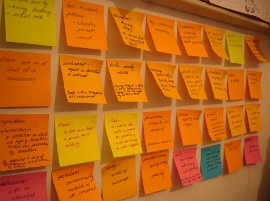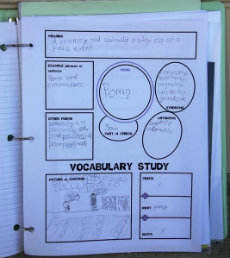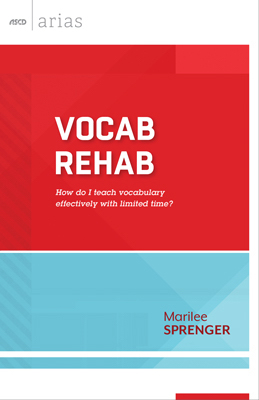The 10-Minute Vocabulary Lesson
 by Marilee Sprenger
by Marilee Sprenger
“I don’t have time to teach vocabulary.” When I was a young language arts teacher, vocabulary was on the list of things to “cover,” so “cover” it I did. With reading, grammar, writing, and spelling, there never seemed to be time for anything else.
Besides that, my vocabulary book contained just enough lessons to do one per week. Even though the words in that vocabulary book were interesting, many of those words were not going to be useful in the future. In fact, most of them were not included in the reading and writing my students were doing in my class or in others.
 Then and now, the days of school are filled to the brim. There is so much content, kids to work with individually, assignments to grade, group work to facilitate, and vocabulary to teach. Vocabulary seems too often to be at the end of a long list, so sometimes you get to it and other times…well, does it really matter?
Then and now, the days of school are filled to the brim. There is so much content, kids to work with individually, assignments to grade, group work to facilitate, and vocabulary to teach. Vocabulary seems too often to be at the end of a long list, so sometimes you get to it and other times…well, does it really matter?
Why vocabulary is important
In those days gone by, I didn’t realize the importance of vocabulary. And its importance cannot be overstated. Students with small vocabularies are more likely to struggle with reading, have difficulty understanding content, and can be seriously at risk for academic failure.
 Assigning vocabulary rather than teaching vocabulary was a waste of my students’ time, but vocabulary strategies that worked were as scarce as time. No one really taught me how to teach it.
Assigning vocabulary rather than teaching vocabulary was a waste of my students’ time, but vocabulary strategies that worked were as scarce as time. No one really taught me how to teach it.
When I learned about the brain and began to understand memory, I researched how the brain is wired for reading and the importance of vocabulary was more evident. Getting vocabulary words into long-term memory was certainly key to helping students understand and remember content.
State standards have set the bar high for vocabulary, and I have set my sights on what words are important for students to learn and what brain-compatible strategies work best.
Fortunately, brief vocabulary encounters work
How do teachers find the time to teach vocabulary, especially teachers in departmentalized situations in which they may only have periods lasting 40-45 minutes? An important piece of research caught my eye and filled me with hope. Students can benefit from brief encounters with words.
“One should not underestimate the value of any meaningful encounter with a word, even if the encounter with a word is relatively small.” (Nagy and Herman)
Taking this information and adding it to other current research, I realized that short lessons would improve vocabulary over time.
How many minutes does it take? In a 40-minute class, ten minutes is 25% of the class time. Is it too much? It will depend on the day, but we must find time to teach academic vocabulary. Those are the “Tier 2” words that are used across content areas. I call them “everybody’s words” as every teacher is responsible for teaching them. Many of these academic words are essential for test success, and many are critical for meaningful speaking, listening, and writing.
Most of my time is spent doing professional development with teachers these days. As I embarked on my vocabulary journey, I found myself challenging those teachers to create lessons in 10 minutes or less.

What can you do with 10 minutes or less?
► In Ten Minutes: have students create a jingle for a word that includes its definition (A jingle for the word clarify might be: clarify and shed some light, explain with details and say it right or clarify to avoid confusion, explain clearly for the right conclusion.)
► In Ten Minutes: (1) pass out blank paper to each student; (2) ask them to fold the paper into quarters (a vertical fold and then a horizontal fold); (3) unfold the paper and write the vocabulary word in the center; (4) in the upper left quadrant have students write their own definition of the word; (5) in the upper right quadrant have them draw a picture that describes the word; (6) in the lower left quadrant have students come up with synonyms for the word, and (7) finally, in the lower right have students either write antonyms or a sentence. During the next time slot for vocabulary, have students share their vocabulary organizer with others, comparing and discussing definitions, pictures, etc.
► In less than Ten Minutes: take attendance and, as you call a name, provide a word from your word wall; the response should be a synonym for the word.
► In less than Ten Minutes: have students write a sentence of 10 or 12 words demonstrating their understanding of one of the vocabulary words.
► In less than Ten Minutes: put students in small groups and have them act out one of the week’s vocabulary words.
► In less than Ten Minutes: introduce a new word, use it in a sentence, and have students create their own definition of the word in small groups; they may use internet sources to guide them.
► In less than Ten Minutes: have students draw a picture or symbol representing a word.
► In Ten Minutes: have students share sentences using words from your word wall.

► In less than Ten Minutes: have students explain how they would teach a vocabulary word to a younger student.
The possibilities are endless
Use academic vocabulary in your classroom on a regular basis and you will begin to hear your students using those same words. If we can explicitly teach about 300 words per year to our students, it can make a big difference in their vocabularies.
Some students will learn about 3000 or 4000 words per year due to the literacy that surrounds them, while others have limited access and will only learn 1000. Imagine how much you will be helping those students who have limited outside access to greater vocabulary.
Also see Marilee Sprenger’s MiddleWeb article:
“25 Words That Trigger Student Understanding”

Among her many other books (all from ASCD) are How to Teach So Students Remember, Second Edition ; Social-Emotional Learning and the Brain: Strategies to Help Your Students Thrive; and The Essential 25: Teaching the Vocabulary That Makes or Breaks Student Understanding. See all of her MiddleWeb articles here.





























Great ideas!
Love these quick ideas!
Thanks for sharing!
This will be my first year teaching writing (instead of reading), and my class will cross three grade levels. These strategies sound effective and practical; I can’t wait to try some of them out. Thanks!
Yes! I’m in the same frame of mind, and your suggestions (and spot-on rationalizations) will be added to what I currently do. Thanks for the post. I’ll also be looking for your books…so nice to encounter another like-minded individual!
Love these ideas!
In ten minutes, my students work together to develop a fake phone app inspired by the word: http://www.corbettharrison.com/free_lessons/Vocab-Phone-Apps.htm
In ten minutes, my students create vocabulary haikus that must use the word in a natural context: http://www.corbettharrison.com/free_lessons/Vocab-Haikus.htm
In ten minutes, my students create vocabulary “anatomy” charts that we can publish in the hallway to teach others: http://www.corbettharrison.com/free_lessons/Anatomy-of-word-and-character.htm
Thanks for sharing these ideas, Marilee!
Hi, Marilee.
Thank you for this list of so many ideas to do in ten minutes. I work with English learners and vocabulary instruction is a gatekeeper to academic success. That’s why I’ve also created a 15-minute vocabulary routine that runs on your same principles – frequent exposure to the target words in various contexts and allow students to engage with the words meaningfully.
The routine I write about (http://www.empoweringells.com/2016/12/10/a17-tier-two-words/) is mainly for academic vocabulary words such as “analyze”, “significant”, “factor”, etc. The routine involves using Powerpoint Slides. Each slide as a question that makes students think such as “What factors might cause you to run late to run?” The slide then has an image as a visual scaffold. Finally, the slide also has a sentence stem such as “A factor that might cause me to rune late is….”. Then students answer it in their notebooks.
We do just 3-4 words a session, then off to class. It can take up to 15 minutes, but usually only takes 10 minutes.
Thanks again for sharing your fun list of vocabulary learning activities.
Hi,
This post made my day. I was looking for great ideas about how to effectively teach vocabulary. Voila!!! This is it!!! Thank you!!!
Wow, you teachers are awesome. This is going to be my first year in the classroom and y’all have given me some great ideas on teaching vocabulary. Wish me luck.